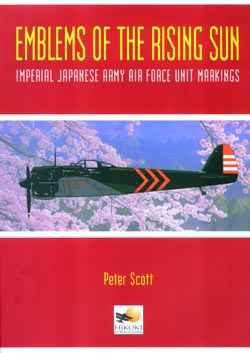 Emblems
of the Rising Sun Emblems
of the Rising Sun
Imperial Japanese Army Air Force Unit Markings 1935-1945
By Peter Scott
Hikoki Publications, 1999
ISBN 1 902109 55 4
128 Pages, Softbound
$26.95 from Specialty Press
The colors and markings of World War Two aircraft are a popular subject
for many authors, but references to the markings of Japanese aircraft
are far fewer than those found in Europe.† This title helps to end that
lack of material and it does it in a big way.† The book is organized into
four distinct sections, with the first part providing a textual overview
of what the main contents are of the book as well as an historical background
to the practice of unit markings.† Immediately following this section
is a brief outline showing the structure of the IJAAF as well as orders
of battle from different dates throughout the decade covered.† This section
is quite important and will be referred to frequently as you peruse the
following section, the actual markings.
The Sentai Markings section of this book is what itís all about and
it is here that youíll find yourself spending the most time.† This section
is broken down into a grid arrangement with columns providing Sentai,
Type, and Period; Sentai Hombu, 1 Chutai, 2 Chutai, and 3 Chutai.† The
rows provide individual Sentais, often having more than one example of
a single Sentai.† In amongst all this information are anecdotes and additional
information for specific Chutai or even the Sentai in general.† In my
quick glancing through I found myself referring back to the orders of
battle to get a better feel for which unit was flying what aircraft at
that specific time, since there are many rows for the same Sentai.† The
unit markings themselves are provided as tail side view illustrations,
with some also including the rear part of the fuselage.
For a more complete view of how these markings were applied, the next
section does just that, providing many pages of side-view profile illustrations.†
The organization of these pages is quite structured and generally follows
the Ki number.† A progression of markings and camouflage throughout the
1930s & 40s is thus presented, offering an interesting look at the
Japanese practices.† To complement this section is the final part of the
book, this being several pages of period photos.
If you have even the slightest interest in Japanese aircraft during
the Second World War, this is one book you must have in your library.†
The incredible amount of research that went into this book is apparent,
and the final result is both easy to follow and as near complete as can
be.
This book, along with other titles in the Hikoki line, is available
from Specialty Press.† A $4.95
shipping & handling charge is applied to each order.
| 







|
 Emblems
of the Rising Sun
Emblems
of the Rising Sun






